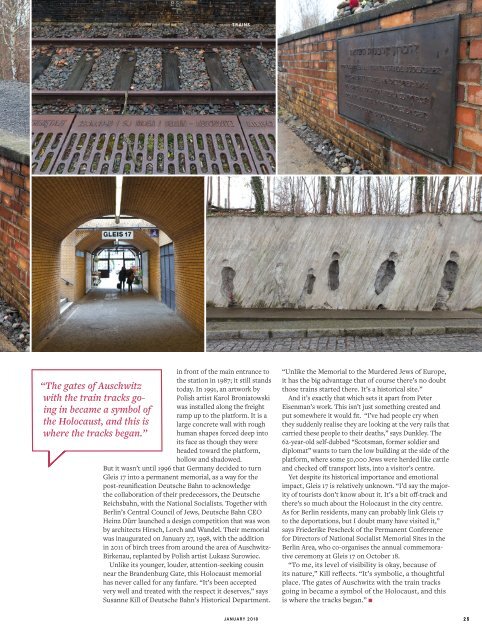Exberliner Issue 167, January 2018
You also want an ePaper? Increase the reach of your titles
YUMPU automatically turns print PDFs into web optimized ePapers that Google loves.
TRAINS<br />
“The gates of Auschwitz<br />
with the train tracks going<br />
in became a symbol of<br />
the Holocaust, and this is<br />
where the tracks began.”<br />
in front of the main entrance to<br />
the station in 1987; it still stands<br />
today. In 1991, an artwork by<br />
Polish artist Karol Broniatowski<br />
was installed along the freight<br />
ramp up to the platform. It is a<br />
large concrete wall with rough<br />
human shapes forced deep into<br />
its face as though they were<br />
headed toward the platform,<br />
hollow and shadowed.<br />
But it wasn’t until 1996 that Germany decided to turn<br />
Gleis 17 into a permanent memorial, as a way for the<br />
post-reunification Deutsche Bahn to acknowledge<br />
the collaboration of their predecessors, the Deutsche<br />
Reichsbahn, with the National Socialists. Together with<br />
Berlin’s Central Council of Jews, Deutsche Bahn CEO<br />
Heinz Dürr launched a design competition that was won<br />
by architects Hirsch, Lorch and Wandel. Their memorial<br />
was inaugurated on <strong>January</strong> 27, 1998, with the addition<br />
in 2011 of birch trees from around the area of Auschwitz-<br />
Birkenau, replanted by Polish artist Lukasz Surowiec.<br />
Unlike its younger, louder, attention-seeking cousin<br />
near the Brandenburg Gate, this Holocaust memorial<br />
has never called for any fanfare. “It’s been accepted<br />
very well and treated with the respect it deserves,” says<br />
Susanne Kill of Deutsche Bahn’s Historical Department.<br />
“Unlike the Memorial to the Murdered Jews of Europe,<br />
it has the big advantage that of course there’s no doubt<br />
those trains started there. It’s a historical site.”<br />
And it’s exactly that which sets it apart from Peter<br />
Eisenman’s work. This isn’t just something created and<br />
put somewhere it would fit. “I’ve had people cry when<br />
they suddenly realise they are looking at the very rails that<br />
carried these people to their deaths,” says Dunkley. The<br />
62-year-old self-dubbed “Scotsman, former soldier and<br />
diplomat” wants to turn the low building at the side of the<br />
platform, where some 50,000 Jews were herded like cattle<br />
and checked off transport lists, into a visitor’s centre.<br />
Yet despite its historical importance and emotional<br />
impact, Gleis 17 is relatively unknown. “I’d say the majority<br />
of tourists don’t know about it. It’s a bit off-track and<br />
there’s so much about the Holocaust in the city centre.<br />
As for Berlin residents, many can probably link Gleis 17<br />
to the deportations, but I doubt many have visited it,”<br />
says Friederike Pescheck of the Permanent Conference<br />
for Directors of National Socialist Memorial Sites in the<br />
Berlin Area, who co-organises the annual commemorative<br />
ceremony at Gleis 17 on October 18.<br />
“To me, its level of visibility is okay, because of<br />
its nature,” Kill reflects. “It’s symbolic, a thoughtful<br />
place. The gates of Auschwitz with the train tracks<br />
going in became a symbol of the Holocaust, and this<br />
is where the tracks began.” n<br />
JANUARY <strong>2018</strong><br />
25


















